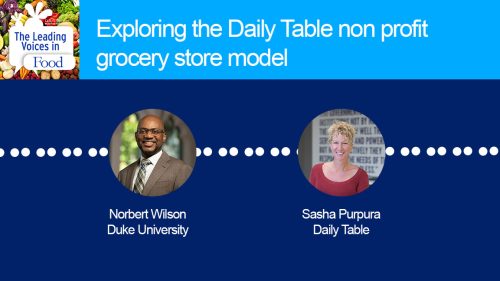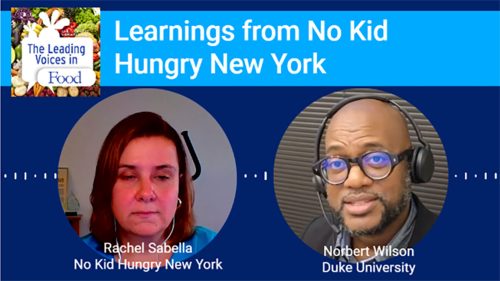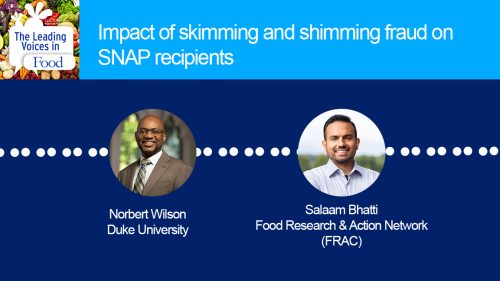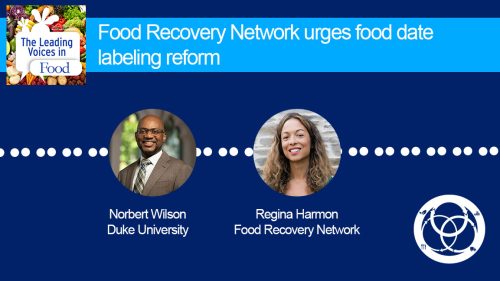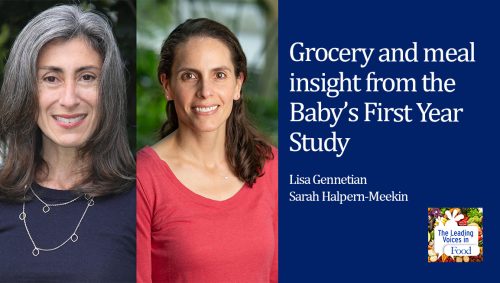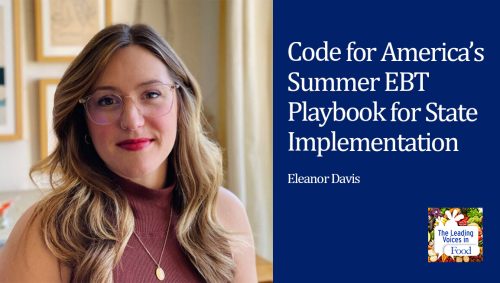E168: Nutrition Security now a Clear Focus for USDA
Poor nutrition is the leading cause of health issues in the United States, with nearly three in four American adults being overweight or obese, and obesity in children and young people being equally concerning. Today, we’re talking with Dr. Sara Bleich, the new Director of Nutrition Security and Health Equity at the Food and Nutrition Service at the US Department of Agriculture. Dr. Bleich is leading the department’s overall effort to tackle food and nutrition insecurity in the United States.
Subscribe: Apple Podcasts | TuneIN | YouTube Music | SoundCloud | PocketCasts | Radio Public
Tags: Equity, Race & Food Justice | Food Insecurity | Food Policy | Social Safety Net & Food |

Sara Bleich, PhD was named Director of Nutrition Security and Health Equity for the Food and Nutrition Service in January 2022. Since joining the Biden-Harris Administration in January 2021, Bleich has served as Senior Advisor for COVID-19 in the Office of the Secretary. Previously, she served as a Professor of Public Health Policy at the Harvard T.H. Chan School of Public Health. Her research centers on food insecurity, as well as racial injustice within the social safety net. She is the author of more than 150 peer-reviewed publications. From 2015-2016, she served as a White House Fellow in the Obama Administration, where she worked in USDA as a Senior Policy Advisor for Food, Nutrition and Consumer Services. Bleich holds a PhD in Health Policy from Harvard University and a bachelor’s degree in psychology from Columbia University.
Interview Summary
Sara, it’s always wonderful to chat with you, and doing so in different roles that you’ve been in. So last time we spoke, you were doing full-time work as a professor at Harvard, and now you’re in this vital position at USDA. I mean, personally, I can’t think of anyone more capable and qualified for this kind of work. And so I’d like to begin by asking if you could explain the purview of your work at USDA.
I’d be happy to, and thank you. It’s really kind of you to say that. And I do want to just underscore that for me, it really is an honor to have the opportunity to serve in this role and to help some of these populations that I care a lot about. And I do feel like so many folks in the public health community have been so generous with their time, their expertise, and have given really valuable feedback, so just really want to say thank you to those of you who are listening. You know who you are. You’ve really been a wonderful sounding board.
So in terms of my transition to federal government, at the start of the Biden administration, I took a leave. I was previously at the Harvard School of Public Health, this was in January of 2021, and I spent the first year as the Senior Advisor for COVID in the Office of the Secretary. And now, in the second year of the administration, I have this new hat, which you mentioned, which is serving as the Director of Nutrition Security and Health Equity, and this is within the Food Nutrition Service. So what’s really interesting for me is that both of these jobs are brand new to USDA, so it’s been really fun to sort of craft them and have the opportunity to sort of start fresh and take on these new responsibilities in very important areas. Now, one thing that they both have reminded me of is just how much I love federal service. This is my second tour of duty in government, and I honestly thought, the first time around, that I wouldn’t like it so much, but I have fallen in love with federal service, I really love working at USDA, it’s such a fun place to work, and I think that’s largely because it has such a broad and diverse mission, so it touches the lives of 330 million Americans every day. I don’t know of another job where you can have that sort of impact. So for me, it’s great to be back. It’s great to have an opportunity to serve, and it’s especially nice to be able to do it in a topic area that I have worked on in my professional life, from the academic side, for so many years.
The enormous impact that this federal work has is clear, from what you just said, and everybody knows this, and in any administration, the country really relies on the service of people like you who are willing to take on these important tasks, so I’d like to say how much I appreciate you doing that. So it’s heartening to know that the USDA is making nutrition security a key priority, and it’s noteworthy that the term food security has become food and nutrition security. Can you explain why this transition has occurred in terminology and how is nutrition security being operationalized?
Great question. Really glad you asked it, because we are hearing a fair amount of confusion about the concept of nutrition security itself. And then how does it differ from the longstanding efforts at USDA to address food insecurity. So let’s start with, first of all, what is nutrition security? So the concept is designed, or aims, to help us better recognize the coexistence of food insecurity and diet-related diseases and disparities. So specifically, what nutrition security means is consistent access, availability, and affordability of foods and beverages that promote wellbeing and prevent disease, and in some cases, treat disease. And this is particularly true among racial/ethnic minority populations, lower-income populations, and rural and remote populations, which includes tribal communities. Now, at USDA, nutrition security builds on and complements our efforts around food security, but it’s different in two distinct ways. The first is that it, it being nutrition security, recognizes that we’re not all maintaining an active healthy life that’s consistent with federal recommendations, and the second is that it emphasizes taking an equity lens to our efforts. So put simply, you can think of nutrition security as having consistent and equitable access to healthy, safe, and affordable food. Now, many listeners may be aware of this definition, and may realize that it directly builds on the JAMA commentary by Dr. Dari Mozaffarian, my assistant, Dr. Sheila Fleischhacker, and Chef Jose R Andres, that came out a little over a year ago. So right now, what we’re spending a whole lot of time doing, and that’s why it’s such a privilege to be on this podcast, is really trying to clearly articulate that definition of nutrition security to a broad range of audiences to really try to get everyone on the same page about what we’re doing and how it is a complement to these long-standing efforts around food insecurity.
I’d like to explore this concept just a little bit more. So if you go back to when the country really started to take hunger seriously, in the 1960s, if the term security had been used back then, it probably would’ve been calorie insecurity, wouldn’t it? There was an effort just to get food to people, irrespective of what it was, because they just needed to get more calories in them. But that’s given way to a much more sophisticated concept that, if I’m hearing you right, not only do you want to get food to people, but the kind of food that specifically promotes health.
That’s exactly right. So what we know right now about burden of disease in the US is that every year, about 600,000 people die because of diet-related conditions. Those are preventable deaths. So the burden of disease looks very different than it did 40 or 50 years ago. And so at USDA, now, what we’re concerned about is not just giving people calories or food that fills up their fridge, but we want to give them calories or food that is also going to promote their health and their wellbeing, and that is the critical pivot, and the point that we’re at right now, with all the messaging that we’re doing, with how we’re positioning the programs, and how we’re prioritizing action as we move forward.
Sara, when we began the podcast, we talked about the very high rates of obesity in the country, and now you’re talking about food insecurity, which people used to refer to as hunger, and a lot of people would see these as the opposite ends of the same spectrum, that they’re somehow different and disconnected from one another, but they’re not. Would you care to comment on that?
Food insecurity and obesity are definitely related. They often coexist. So we know, for example, that both food insecurity and excess body weight, which you can think of as obesity, they tend to be aggregated among historically disadvantaged populations. So communities of color, low-income populations. And because these two conditions coexist, it’s really important to think about how do we use the power of the federal nutrition assistance programs to help move people out of food insecurity and toward nutrition security. And the power of the federal nutrition safety net is that it has a number of programs which are designed to do both. So, for example, if we look at SNAP, the Supplemental Nutrition Assistance Program formally known as food stamps, it helps about 41 million Americans – in fact, more than 41 million Americans, afford food each month. There’s strong evidence which suggests that it pulls people away from food insecurity, so it lifts families out of hunger. But what we also know is that with the historic reevaluation of the Thrifty Food Plan, which is the calculation that underlies the size of the SNAP benefit that increased the benefit amount by 21%. This happened back in the fall of ’21. What that does is, it puts healthy food within reach for so many participants who are on SNAP. So we view this change to SNAP, this reevaluation, which is the first permanent increase in over 45 years, we view this as core to our nutrition security efforts because it allows families to actually purchase food and put those foods within reach that are going to promote their health and their wellbeing.
Thanks for that explanation. So it sounds like some of your work lies at a very interesting intersection of two important priorities of the current administration. So on one hand, you have USDA Secretary Vilsack’s goal of promoting and elevating nutrition security, which you’ve discussed, but also the President’s goal of advancing racial equity. So what things are happening at this particular intersection of USDA?
Well, first I’ll say this is an exciting time to be in government because there is so much focus on core issues that matter a lot. And so a key reason why the Secretary of Agriculture, which is Secretary Vilsack, the key reason why he is so passionately focused on nutrition security is really due to the pandemic, and the President’s goal of advancing racial equity. So what we all know is that COVID-19 brought health disparities and the vital need for access to healthy food right up to the forefront. There’s a study, which many listeners may be familiar with, which estimated that nearly two thirds of COVID-19 hospitalizations in the United States were due to four diet-related conditions: obesity, diabetes, hypertension, and heart failure. And so for this reason, given the disproportionate impact of COVID, its impact on diet-related conditions, and we know that it really disproportionately impacted communities of color, equity is central to our work to promote and elevate nutrition security. And so just to keep us all on the same page, let me just quickly say what we mean by equity: everyone having an equal opportunity to live the healthiest life possible, no matter who they are, where they live, or how much money they make. But when we talk about equity that also dovetails with considerations around the context in which we live. This means we also have to consider structural racism, and this is how we bring in the racial equity lens. So structural racism is not just individuals having prejudices, but it’s also when racism gets produced and reproduced by laws and by rules. It becomes embedded in the economy, and so therefore, confronting racism requires that we don’t just change how individuals think, but we also start to transform policies. In our efforts to build awareness around nutrition security, we are also making very concerted efforts to explain how structural racism is real, it reaches back to the beginnings of US history, and it stretches across our institutions and economy. So we emphasize that structural racism harms health in ways that can be described, measured, and dismantled. And this is a really important needle to thread as we think about nutrition security, because social disadvantage is not random. It has real roots that we need to acknowledge, and then address wherever possible. So for example, we know that there are disparities in diet-related conditions that have existed for decades, and those are associated with structural limitations to retail food outlets that sell healthier foods, among a whole host of other longstanding historical inequities. And this is where the work of nutrition security comes in, where we at USDA, and hopefully, all the listeners of this podcast, can really make a difference.
So I would challenge you all to lean in and ask yourself how can you be part of the solution. And maybe that’s asking a critical research question, maybe it’s trying to help connect eligible individuals with the federal nutrition assistance programs, but there are so many opportunities to promote and elevate nutrition security. And the key, going back to your question, is that the President cares about this, the Secretary of Agriculture cares about this. This is a window of opportunity to really make a difference in people’s lives. And so I think that we really want to lean in as much as possible and take advantage of it.
This work is really important, so following up on something you just said about ways that people can engage with this process, so what kind of things are you seeing on the horizon, and what are the best ways for people who might be listening, to engage?
So I think it’s going to depend on the lane that you sit in. If you’re listening to this podcast and you’re a researcher, I would ask yourself, “Given the data that I’ve collected, given the data that I plan to collect, could I do a secondary analysis that might help me understand some of the impacts of the COVID flexibilities that have happened during the pandemic?” For example, there was a temporary increase to the SNAP benefit, and then that became a permanent increase. There have been hundreds of waivers that have been issued which have made the programs more easily accessible. So for example, with WIC, you don’t have to go in in person, you can do meetings over the phone. There are all sorts of things, all sorts of program modifications that have happened, and USDA doesn’t have the bandwidth to do all that evaluation. So I’d say if you’re a researcher, look at how your existing data, your existing portfolio, may be able to answer other important questions.
Second, if you are industry, or if you’re somehow in the private sector, ask yourself, “What could I do to lean in on this?” For example, there is a waiver that’s allowed, it’s called the SNAP Incentive Waiver. Retailers can apply for this and it allows them to incentivize SNAP participants to purchase things like fresh fruits and vegetables, and whole grains that are in alignment with the dietary guidelines for Americans. This has been around for a few years, and it’s a really nice way that retailers could take advantage of an existing waiver to try to help promote healthy eating purchases among SNAP participants. Which, again, covers about 41 million Americans each month. There are so many different ways to think about leaning in on this particular issue. And I would say that one of the things that we have really tried hard to do over the past several months is that we at USDA are trying to really clearly define our role. How we are trying to make a difference – with the hope that it makes it obvious how others can do complementary activities, because yes – we are investing tens of billions of dollars towards this portfolio. We are very serious about it. This is a top priority. But USDA alone cannot solve the problem of diet-related diseases and disparities. It is going to take a whole-government, if not whole-country approach. And so this is where creative ideas about how to make a difference, leveraging existing resources, is where many of you who are listening can make a difference.
Thanks for that. By the way, this focus on equity and this idea that the whole country can engage to help address these issues feels very optimistic, and just like there’s hope for the future of really addressing these problems in a fundamentally different way. So back to your career: you’ve been in both academics and in federal service, as you mentioned earlier. So what makes you passionate about nutrition security as an issue, and do you have advice for people that might be interested in federal service?
I love questions like this, largely because when I was starting off my career, it would’ve been so helpful to hear what motivates people. So for me, my north star is that I’ve always wanted to help historically underserved populations, communities of color. How do I help them achieve a better quality of life? I’m from inner-city Baltimore. I have a twin sister and an older brother. My parents still live in the same house that I was raised in, and they were public school teachers, they’re now retired, and when we were young, our family received food stamps, now SNAP, we received WIC, we received school meals. So I’ve always been very motivated to give back to the communities that have given me so much. And I think that our current reality is that every child and every person in this country doesn’t have an equal opportunity to live a healthy life. And that’s not the way that it should be. So every day, I am very, very motivated to ask myself what can I do to help push us in that direction, and push us in a meaningful way. I think the challenge is always, you can push hard but you want to push hard on things that are moveable, where you can actually make a difference. Because everything is all about timing and you want to just be very strategic about where you’re going to make investments or put your energy in an area. Because this is where there’s an opportunity. And I would say that if we can achieve nutrition security, it is going to change people’s lives. Diet-related diseases are preventable. Hundreds of thousands of people a year don’t have to die from them. And that’s particularly true among communities of color. I think that many of you listening probably feel the same, but these are things that need to change. As I mentioned earlier, I do think we are at a moment where there’s a window of opportunity to make a difference. And I would say, more practically, if you’re interested in federal service, I would strongly encourage you to just throw your hat in the ring and apply. So you can either go through the career staff route, you could go through the political route. If you go through the career staff route, the Food Nutrition Service at USDA is going to be hiring about 450 people in the not-too-distant future, and that process has started, so I would look at usajobs.gov and see what looks interesting. And I would also consider some of the political jobs, thinking about different fellowships that would allow you to insert yourself. I never expected to love government so much. I never expected to come back again, this is my second tour of duty, but I have just absolutely loved it. And then personally, it’s such a pleasure to be able to work on the programs that I was able to benefit from as a child. So for me, it motivates me. I find it very exciting. And I think that for those who are in research and that choose to spend some time in government, I truly think it will make you a better researcher, because what it will teach you is that not every important question is urgent, and what are the urgent questions on which you should really focus your energy.


